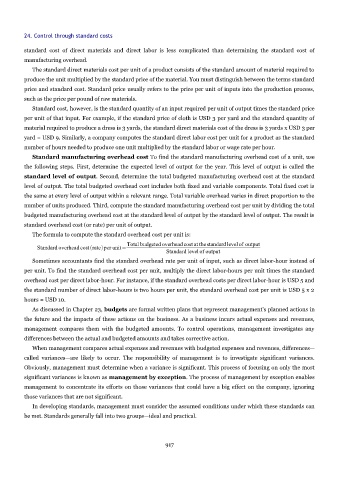Page 916 - Accounting Principles (A Business Perspective)
P. 916
24. Control through standard costs
standard cost of direct materials and direct labor is less complicated than determining the standard cost of
manufacturing overhead.
The standard direct materials cost per unit of a product consists of the standard amount of material required to
produce the unit multiplied by the standard price of the material. You must distinguish between the terms standard
price and standard cost. Standard price usually refers to the price per unit of inputs into the production process,
such as the price per pound of raw materials.
Standard cost, however, is the standard quantity of an input required per unit of output times the standard price
per unit of that input. For example, if the standard price of cloth is USD 3 per yard and the standard quantity of
material required to produce a dress is 3 yards, the standard direct materials cost of the dress is 3 yards x USD 3 per
yard = USD 9. Similarly, a company computes the standard direct labor cost per unit for a product as the standard
number of hours needed to produce one unit multiplied by the standard labor or wage rate per hour.
Standard manufacturing overhead cost To find the standard manufacturing overhead cost of a unit, use
the following steps. First, determine the expected level of output for the year. This level of output is called the
standard level of output. Second, determine the total budgeted manufacturing overhead cost at the standard
level of output. The total budgeted overhead cost includes both fixed and variable components. Total fixed cost is
the same at every level of output within a relevant range. Total variable overhead varies in direct proportion to the
number of units produced. Third, compute the standard manufacturing overhead cost per unit by dividing the total
budgeted manufacturing overhead cost at the standard level of output by the standard level of output. The result is
standard overhead cost (or rate) per unit of output.
The formula to compute the standard overhead cost per unit is:
Total budgeted overhead cost at thestandardlevel of output
Standard overhead costrateper unit=
Standard level of output
Sometimes accountants find the standard overhead rate per unit of input, such as direct labor-hour instead of
per unit. To find the standard overhead cost per unit, multiply the direct labor-hours per unit times the standard
overhead cost per direct labor-hour. For instance, if the standard overhead costs per direct labor-hour is USD 5 and
the standard number of direct labor-hours is two hours per unit, the standard overhead cost per unit is USD 5 x 2
hours = USD 10.
As discussed in Chapter 23, budgets are formal written plans that represent management's planned actions in
the future and the impacts of these actions on the business. As a business incurs actual expenses and revenues,
management compares them with the budgeted amounts. To control operations, management investigates any
differences between the actual and budgeted amounts and takes corrective action.
When management compares actual expenses and revenues with budgeted expenses and revenues, differences—
called variances—are likely to occur. The responsibility of management is to investigate significant variances.
Obviously, management must determine when a variance is significant. This process of focusing on only the most
significant variances is known as management by exception. The process of management by exception enables
management to concentrate its efforts on those variances that could have a big effect on the company, ignoring
those variances that are not significant.
In developing standards, management must consider the assumed conditions under which these standards can
be met. Standards generally fall into two groups—ideal and practical.
917

